Europe’s largest fire festival might feature Vikings, Ninjas, and men in dress, but it also represents the soul of this remote Scottish archipelago.
LERWICK, Shetland Islands–
Neil Robertson stood atop his Viking longship, staring blankly into the distance. His shaggy face was flushed red with the heat of a thousand flaming torches, and the plume of his raven-winged helmet shook gently in the breeze. The men carrying these torches were raucous, drunk on joy and the whisky they kept in their tunics. They gathered in a great incendiary ring around the longboat that clogged the night air with thick smoke. Some of the men, like Robertson, dressed as Vikings, while others came as women, Ninja Turtles, and Power Rangers.
The crowd shouted up at their man, calling his name and pleading for him to do what they had all come to see. Robertson, however, remained impervious to their pleas. He stayed silent and seemed somewhere else in his mind. He was euphoric but also incredulous. He had waited fifteen years for this moment. He had seen countless other men go before him, and it was now his turn.
The roars from the mob were getting louder. The torches heaved and swelled in a sea of fire, but Robertson held onto to his time for just a second longer. He couldn’t let it finish.
Then he raised his axe. The noise stopped. Torches everywhere lowered. The air was bitter with paraffin and heavy with the crowd’s breath.
Fifteen years had come to this.
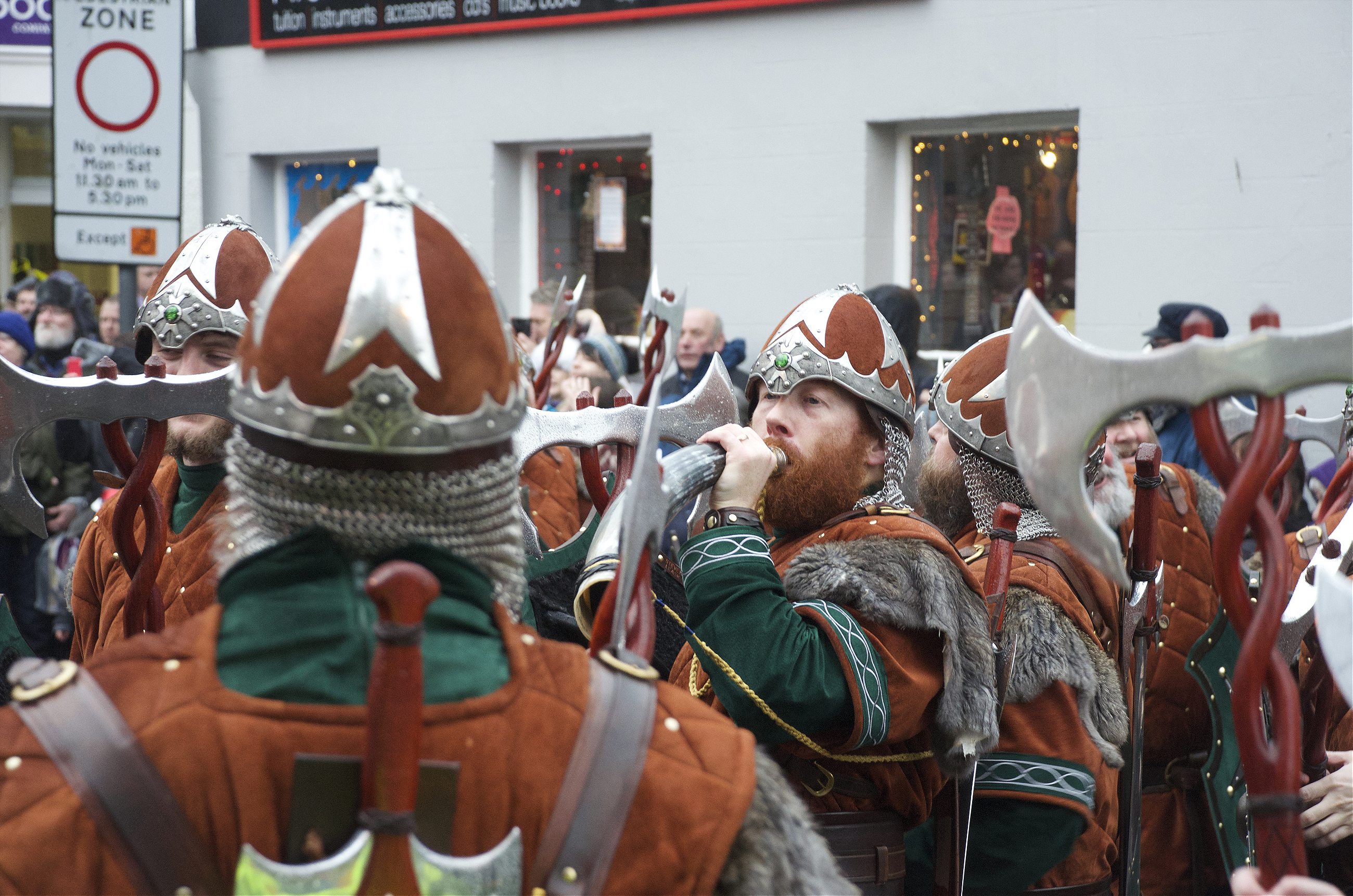
The Up Helly Aa festival is celebrated on the last Tuesday of January every year in Lerwick, the capital city of Shetland, a sub-Arctic archipelago of Scotland that lies some 100 miles northeast of the Scottish mainland. It is Europe’s largest fire festival and includes vibrant, boisterous processions, with up to a thousand participants dressed in elaborate disguises. Although the Viking element of the festival is particularly marked, it is, in fact, a relatively modern celebration. It signals the close of the Yule season and was born out of the unruly end-of-year revelry that occurred on the islands at the beginning of the 19th century. Indeed, its name “Up Helly Aa” is old Norse for the end of the holidays.
I first heard of the Up Helly Aa from my grandfather, an ex-fisherman who used to work off the Shetland coast. He told me many tales of the islands: of barnacled hard-drinking fishermen, hulking Nordic farmhands, and violent, evil seas. He spun yarns of the Vikings and the torchbearers known as guizers, who warded off the grim darkness, and the drinking that killed the cold. Most of these stories, knowing my grandfather, were either greatly exaggerated or made up, but his enthusiasm for them made me want to go and see for myself. I wanted to see the fire and the Vikings, but more importantly I wanted to visit the islanders who had animated his tales.
I landed at Sumburgh, Shetland’s main airport, a few days before the festival. From there I was to drive to Lerwick, where I had organized to meet up with some of the event’s participants. As I made my way from the airport, the sea was as gray and as smooth as slate. Hills rolled gently to the edge of vertiginous cliffs, and blanket bogs wallowed in the valleys. Occasionally, I saw a small hamlet, populated with squat, whitewashed houses. There were flocks of sodden sheep and lone cows staring disinterestedly out to sea. But, there were no trees, only clumps of rough, brownish grass, and soggy heather. The wind blew hard, and it rained thick, heavy rain.
Shetland was inhabited as early as 3000 B.C., invaded by the Vikings in 800 A.D. and annexed by the Scots in 1471 as part of the dowry for a Danish princess. For much of the 16th and 17th centuries, the islands traded their goods through Hanseatic merchants from Germany and, although officially Scottish, maintained a culture distinct from that of the mainland. In 1707, with the signing of the union between England and Scotland, the islands became officially British, and the Hanseatic traders were kicked out. Slowly, and perhaps not always willingly, Shetland became part of the British state.
I was seated in a small gymnasium, watching twenty or so ninjas dance around four ninja turtles
When I reached Lerwick, the wind and rain had not dissipated; a howling North Sea gale whipped down the waterfront and water dribbled and dripped from the window-ledges of the 18th-century sandstone houses that lined the esplanade. The harbor was full of large trawlers unloading their catches and fishermen dressed in oily yellow overalls shouting inaudibly at one another across the wind. Dockworkers slid boxes of white fish across the harbor floor into large corrugated iron sheds. Local buyers contemplated the boxes with furrowed brows and worn clipboards while weary sea captains accepted whatever price.
I met Steve Henry, a local builder and regular attendee of Up Helly Aa, at his house in Lerwick’s New Town. Henry moved quickly and spoke even faster. His accent was thick, but his tone, as it is in the Shetlands, was melodic. He used local words like peerie (small) and muckle (big) and maintained a boyishly enthusiastic grin as we spoke. Pressed for time, he invited me to watch a performance he and his friends were preparing for the festival at the local high school.
Some 10 minutes later I was seated in a small gymnasium, watching 20 or so ninjas dance around four Ninja Turtles. Men and boys of all sizes swung and twisted to pop music while a local woman yelled out instructions. I was confused. Where were the Vikings?
Henry told me that it was complicated and that there were many aspects of the festival that had been obscured by the Viking-obsessed press. First of all, these men formed part of what is known as a squad. There are 47 squads in total. Some of them are decades old while other are new to the festival that year. The only fixed rule is that to be a part of one you have to have been born on the islands or have lived there for five years. “Every year each squad dresses up as belly dancers, rock stars, penguins—or whatever takes their fancy—to take part in the festival,” Henry told me.
For the squads, the festival itself is split into two major parts. First is the torch procession in which participants known as guizers march through Lerwick’s streets with torches, and second is the afterparty. In this part, each of the 47 squads sets off around the town to a total of 11 venues, known as halls, where they drink, dance, and perform a skit about island life. This skit is what the men were practicing in their ninja costumes.
And the Vikings?
“Each Up Helly Aa, there is only ever one squad who can dress as Vikings,” Henry said, “and these guys are the main event of the festival and have different responsibilities.”
This squad that gets to be Vikings on any given year is called the Jarl Squad and is led by its ax-brandishing boss, the Guizer Jarl. Guizer Jarls are all members of the 15-seat Up Helly Aa committee. Members are elected by their fellow guizers every October but must wait 15 years for their turn as the Guizer Jarl.
“It’s a big job and the 15-year wait to be a Jarl is a long one,” said Stephen Grant, who performed the role in 2013. “I was elected to the committee in 1998 and had to wait until 2013 until it was my turn.”
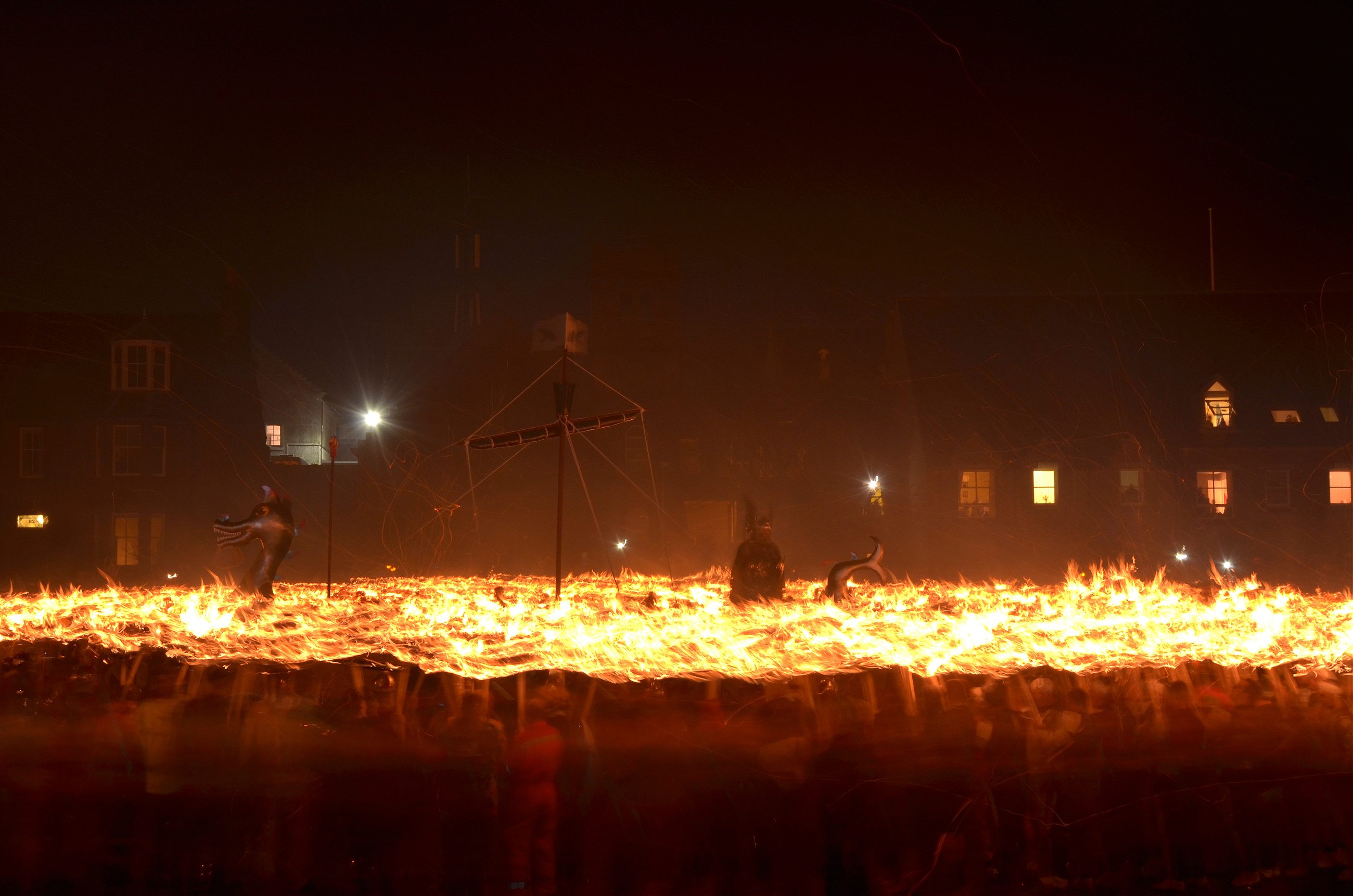
I met Grant in the gymnasium during the practice. Two years ago he led this squad of present day Ninjas through Lerwick’s streets as riotous Vikings. Back in a standard squad he reflected on the rigours and pleasures of being on the festival’s center stage.
“Preparation for the Jarl Squad takes place two years before its allotted year. You have to speak to the Jarl squads before you, to make sure that you don’t come up with the same design for the costumes,” he says.
Unlike the majority of squads, whose costumes are bought hurriedly before the start of the festival, the preparation for the Jarl Squad’s outfits is meticulous. The Jarl creates the look of his squad, from the type of helmets his men wear to the color of their kirtles. Then, over the course of a year or so, the members meet up several nights a week to make these garments. Grant estimated that his squad’s suits cost some £1,700 ($2,600) per person, all of it self-funded.
“When I was first elected Jarl, every member of my squad put in £10 a month from the day I was elected to contribute to the funding of the suit and its accessories,” Grant said.
And as well as some hefty financial commitments there is also the question of time. In the year leading up to the festival, Grant told me that he, and most of his squad, worked on something Up Helly Aa-related every night of the week. And he managed it all while working a full-time job as a tugboat master at the island’s oil refinery.
“Working on something day in day out is stressful, but it also creates a deep camaraderie among the squad members,” Grant said. “The saddest thing is when it ends. You work with the committee members for over a decade, and then, one day, you’re out.”
As the men repeated their skit for a fifth time, I became curious about another notable absence There were no women in the squad. I brought this up with an older woman seated next to me on the bench, who introduced herself as a mother of one of the ninjas. She smiled and told me that women have never taken part in the processions of the Lerwick Up Helly Aa.
“Normally, they host the halls,” she went on, “organizing food and drink for the incoming and outgoing squads.”
The absence of women in the Lerwick Up Helly Aa has produced much debate among the islanders. Most Shetlanders seem to want change. A poll conducted by a local paper suggested that 68 percent of its readers would like to see more female inclusion. But some, including some women, think things should remain as they are. Robina Barton, a local council worker, would later tell me, “Gender equality doesn’t mean having to do everything the other sex does… and I see no harm in a bit of male bonding.”
Few men from Lerwick, whatever their social class, have failed to take up this opportunity for “male bonding” at some point in their lives. University of Glasgow historian Callum Brown, in his book about Up Helly Aa, estimates that as many as two-thirds of Lerwick men aged between 18 and 40 participate in squads in any given year. Being in a squad endows a sense of belonging. These groups are not hastily organized for the festival but familial clubs that last throughout the year and beyond.
“We’ve had people coming back from Australia and Hong Kong to join up with the squad for the festivities,” Henry said.
The squad is an active community around which many of the men’s social lives revolve.
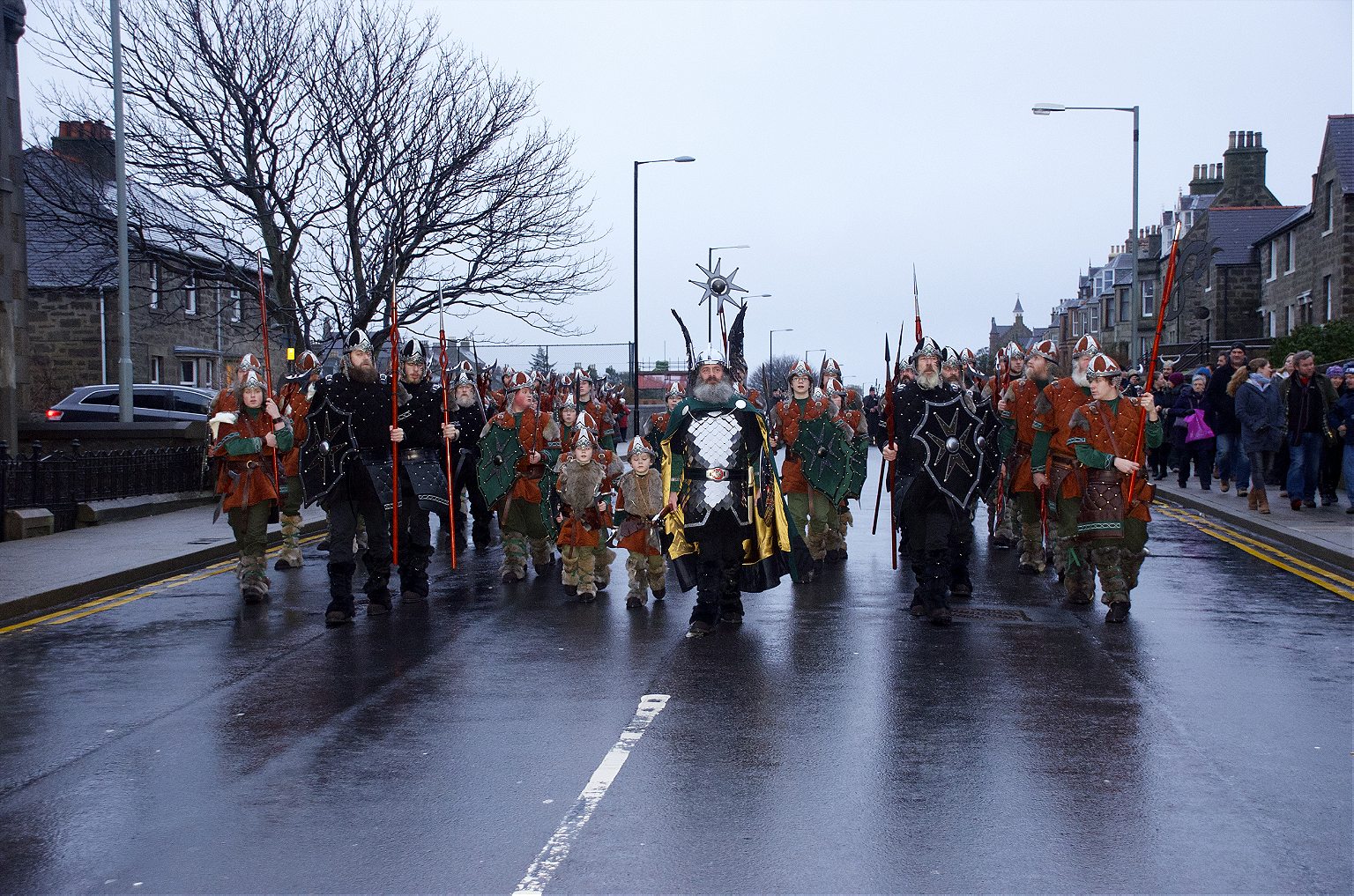
On the morning of the festival, it was dark and cold. The dirty yellow light of the street lamps spilt onto the road, and the wind blew relentlessly. It was around seven in the morning, and I was in Lerwick’s Market Square, just off the Esplanade. Next to me stood a woman and her dog. The woman wore a tight beanie that squashed her hair into her face, a puffy gilet and baggy trousers tucked into her boots. The dog shivered in the wind.
“I never sleep very much,” she said, “so it’s not unusual for me to be here at this time in the morning.”
A large placard, some four meters high and known to the islanders as “the Bill,” stood in front of us. It was painted in a bold, black font and stamped, in a thick splodge of red wax, with the Guizer Jarl’s seal. At the bill’s head, in large ornate letters, it read, “proclamation.” Organizers post all the information about the day’s events here, including a lot of jokes at the expense of the locals.
These jokes are collected throughout the year by a special Joke committee. When some incident, sufficiently ludicrous or embarrassing, occurs, it is filed away for use on “the Bill.” The committee then gathers the night before the festival and paints the proclamation by hand.
“Some people have become very upset by the jokes on here,” the woman told me, chuckling. “There have been feuds.”
On the other side of town, the Jarl Squad’s morning procession was due to start. In spite of the weather, people had come out to see the first of the parades. Young children, wrapped up like rolls of carpet, tottered and swayed under the weight of their clothing. Semi-sentient teenagers peeked out from dark hoods and wet fringes semi-interestedly. Old men reminisced from behind soft smiles. Proud fathers stood behind their sons, acknowledging other parents doing the same thing. And everywhere, people remembered why this day meant so much to them.
Slowly, the squad began to materialize. It was the first time any of the locals had seen the Vikings, their costumes having been a closely guarded secret for two years. Some came dressed in brown tunics and emerald green undershirts while others wore heavy black kirtles. Some brandished axes and swords, others, long, ornate spears. Most sported thick beards and sly, whisky grins. There were children too, boys from eight to fifteen, huddled behind their fathers and grandfathers.
At their head was the Guizer Jarl, fifty-two-year-old engineer Neil Robertson. Today he was King Olav Haraldsson of Norway, his chosen figure from Norse history. He wore a chromium-plated helmet with raven’s wings rising high on either side, a bodice of shiny armor and a bulky belt. His small, silver shield had a raven engraved on it.
Robertson looked on at his men and then at the crowd and smiled nervously. He let out a roar, and his squad bellowed back. He thrust his axe into the air, and his squad followed suit. Then, he gave a firm nod and began to march; at his back, bagpipes groaned into tune. Although Robertson had first paraded in a squad when he was nine-years-old and had taken part in almost every Up Helly Aa since then, this was all new to him.
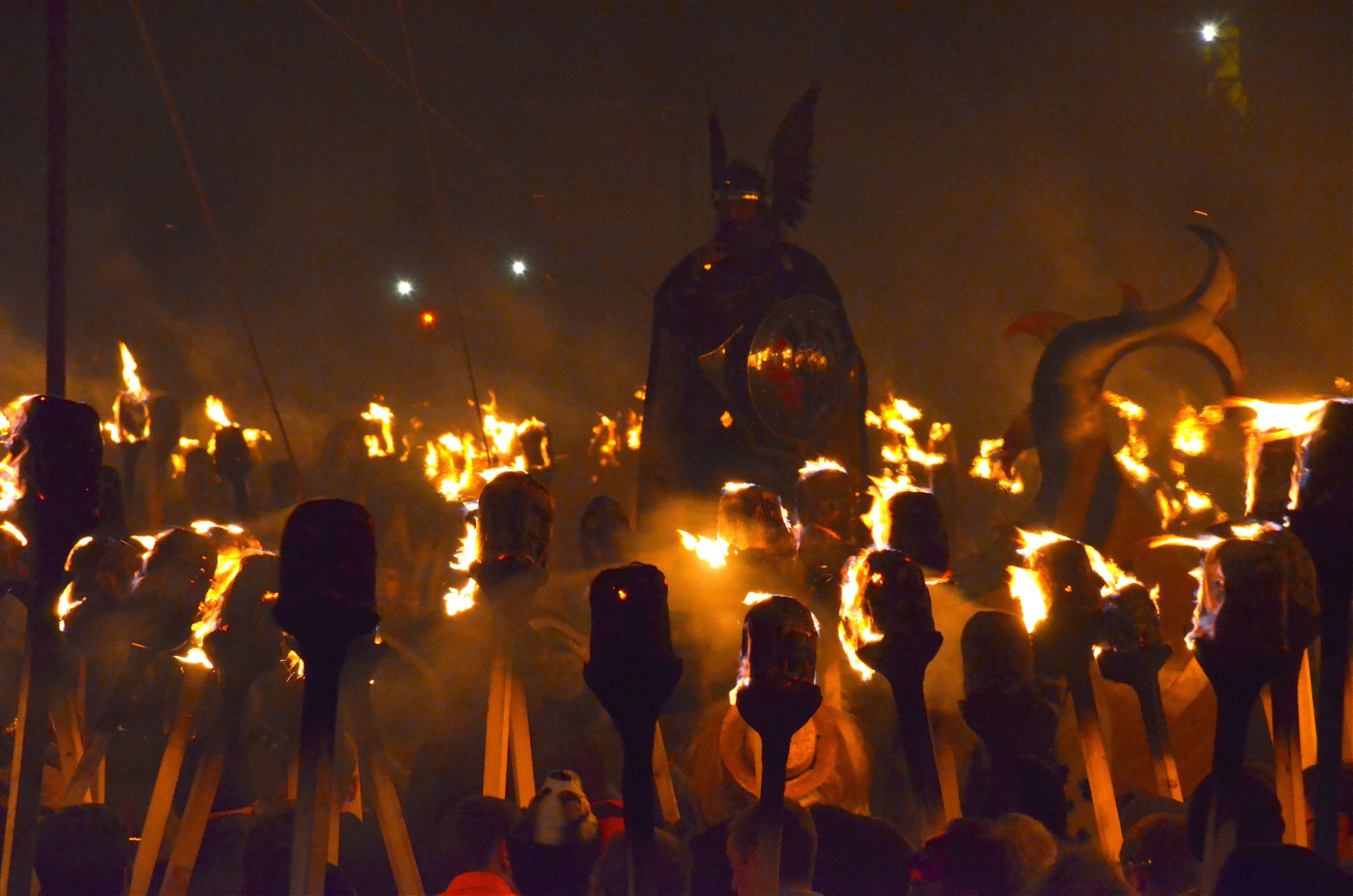
Stephen Grant recalled how surreal the whole experience was: “It just comes out of nowhere, and then people are calling your name out on the street.” David Nicolson, who served as Jarl in 2012, described it as an inexplicable feeling: “It’s a bit like trying to describe becoming a parent to someone who hasn’t had children. Unless you’ve been there, you can’t really know how it feels.” Alan Anderson, Jarl in 1971, was far more equivocal: he said that being Jarl was the best experience of his life.
The Jarl Squad marched all over town. They visited schools, ex-servicemen and old-folks’ homes and processed down nearly every street in Lerwick. Everywhere they went, they were met with loud cheers and adulation.
By the end of the squad’s morning parade, the town had come to a standstill. By the waterfront, empty narrow lanes snaked around the corner of wind-worn houses and closed shop fronts. It was dark again. The lights from houses reflected off the greasy sheen of the pavements, and the lights in the public buses showed no commuters. In the new town, full of neat Victorian villas and manicured gardens, town officials were setting out barricades and cordoning off roads.
Slowly, at around 6 p.m., the first signs of revelry crept into the bleakness of the night. Two old men came bumbling down the hill sharing swigs from a hip flask like sneaky adolescents. They wore gummy smiles on their gnarled faces and spoke in breathless tobacco wheezes. One started to sing a local song while the other moved his hands in the manner of a conductor.
“Up Helly Aa is a great day, isn’t it?” one said
“Aye,” the other slurred back. “It’s a good old excuse fir a drink n’ a celebration.”
As Robina Barton told me, for most Shetlanders, “Up Helly Aa is an opportunity for a party.” It’s about having fun and celebrating island life. Though much discussed in the press, preserving and celebrating the island’s Norse identity is a much lower priority.
Although the central image of today’s festival is the Viking, in the 1840s, Up Helly Aa was an inferno of burning tar barrels and boisterous boozing. Searing barrels would be let off from opposite sides of the town and would meet in terrific explosions at its centre. There was not a Viking in sight. Even in 1881, after tar-barreling was banned and residents organized the first procession of torches through Lerwick, no Norse mythology existed.
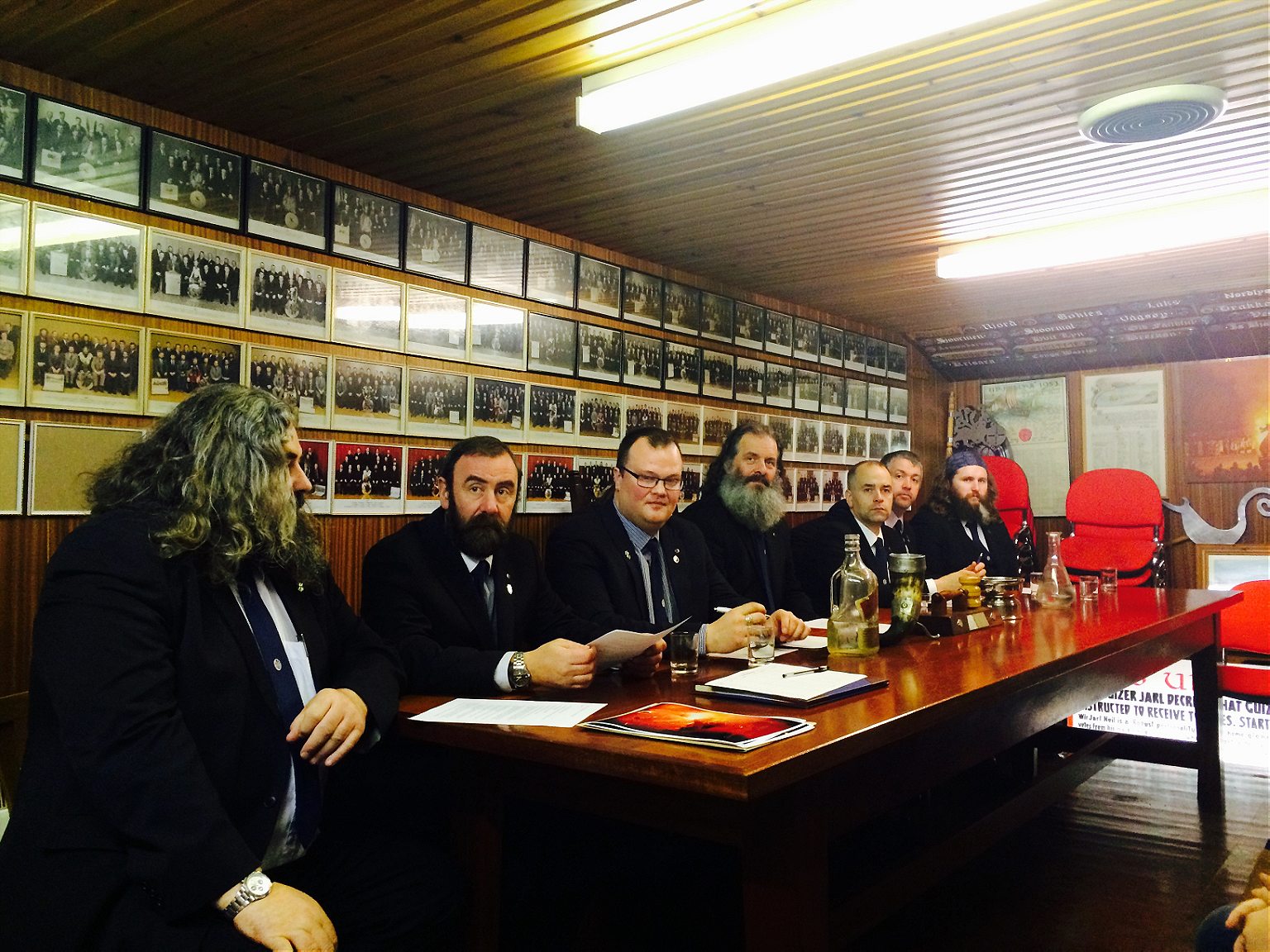
It was only from the late 1880s onward that Nordic elements began to appear in the festival. Around his time, many Shetlanders felt oppressed and exploited by their Scottish landowners, who they believed had stolen local land through landholding laws written almost three centuries previously. The Scots represented a culture and a way of governance that did not represent the islands. But the Vikings had been absent from island life for almost 500 years and, according to local historian Brydon Leslie, little, if anything, was known about them. The Shetlanders knew they were not Scottish, but anything beyond that they couldn’t be sure.
Elsewhere, Britain was undergoing a romantic renaissance, promulgated by the literature of Sir Walter Scott. One of his novels, The Pirate, was set in the Orkney and Shetland islands and brought vividly, if erroneously, to life the islands’ Norse past. Jumping on this Norse revival, local intellectuals looking to crystallize island identity, disseminated these ideas around the islands. Soon, under the influence of local Marxist historian J. J. Haldane Burgess, Norse mythology became part of Up Helly Aa. The burning ship was introduced in 1889, the Guizer Jarl in 1906 and the first Jarl Squad shortly after the end of World War I.
However, the Viking revival reached saturation point soon after. When, in the 1930s, some of the remaining Nordophiles began reproaching the Up Helly Aa Committee for allowing guizers to choose fancy dress over Viking tunics, Charles Manson, the Committee secretary, replied emphatically. He stated that it was the guizers’ enthusiasm that kept the spirit of Up Helly Aa alive, be they dressed as Vikings or indeed ‘dancing girls,’ and not Norse mythology. To reinforce his point, in that year’s festival a picture of two rather feminine Vikings appeared on the Jarl’s Bill.
“The [Viking element] is something that present day Nordophiles like to play on,” said Brydon Leslie. “They like to talk about Shetland’s nationhood, our Norse heritage, and how Up Helly Aa is a prevailing Viking festival, but I know each member of the current Up Helly Aa, [and although] they are all 100 percent committed to Up Helly Aa, that does not necessarily imply that they are interested in Vikings.”
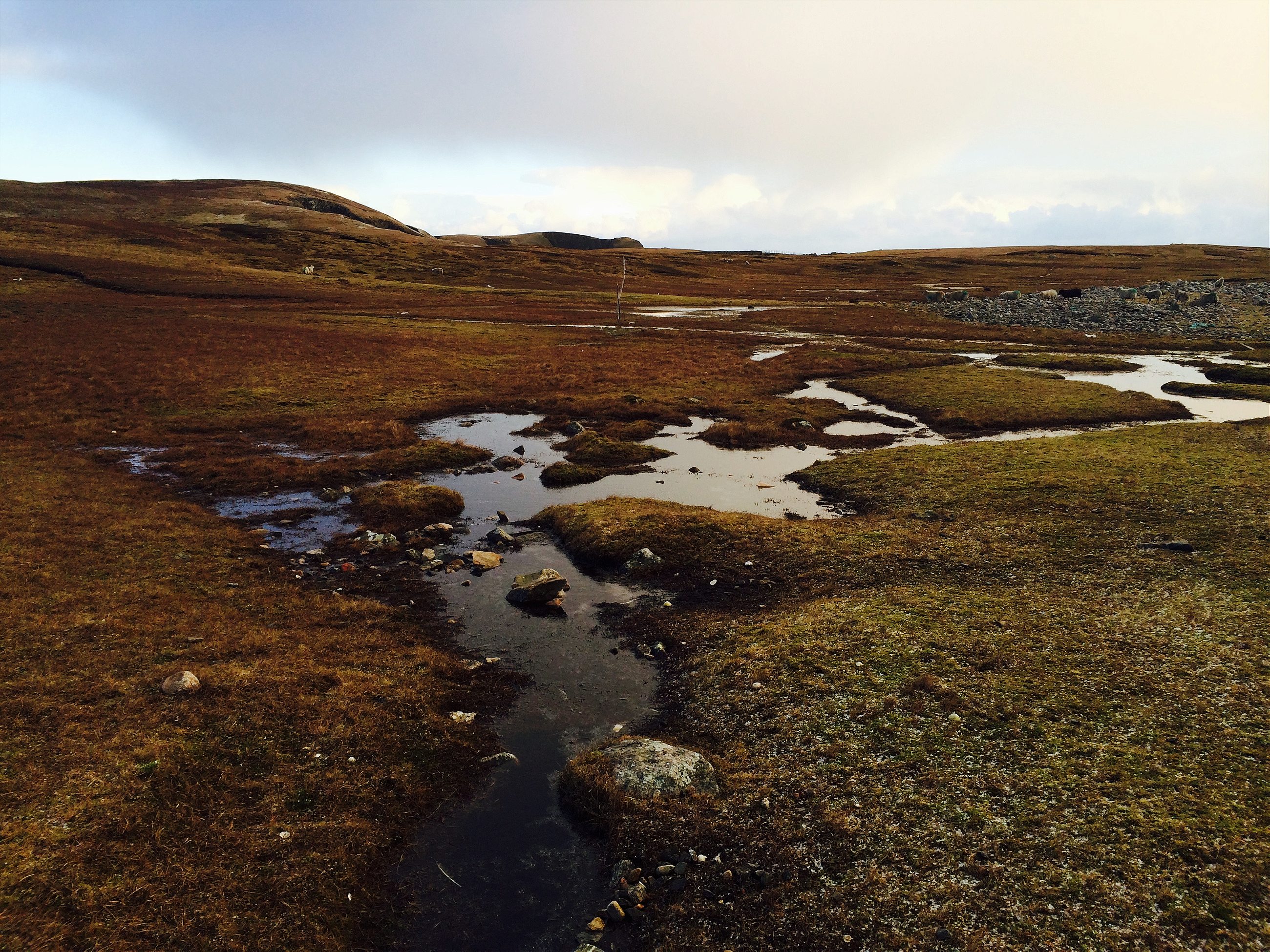
Lego men, mice, Power Rangers, Clangers, ninjas, Ninja Turtles, belly dancers, cross-dressers, and penguins all stood together in long lines. They joked and jostled, grunted and burped, and waited eagerly for the Vikings to arrive. In their hands, they carried meter-long unlit torches soaked in paraffin.
Further down the road sat a Viking longship. Some 30 feet long and low-waisted, its prow curved up swanlike into a large dragon head, and its stern whipped into a serpentine tail. Known to the islanders as the “galley,” the boat is built by craftsmen and volunteers over a period of four months and is the same basic shape each year.
“It’s beautiful, but it’s made to burn,” said a local man who was standing beside me.
From the west came the sound of pipes and the waiting guizers stiffened to attention. The Jarl marched through their ranks and then climbed aboard his ship. His men lined up around its sides and stared severely into the night. The Jarl gave a nod, and a maroon went up into the sky. Then, everything went dark, and some 5,000 spectators fell into inquisitive murmurs.
Marshals, holding hissing distress flares, went from guizer to guizer lighting torches. Overhead fireworks screeched and cracked. On the scaffolding above, brass band played the Up Helly Aa song, and the guizers joined in hoarse voice:
“On distant seas, their dragon-prows went gleaming outward-bound, the storm clouds their banners, and their music, ocean sound… ”
And when almost every torch was lit, the longship set sail to Valhalla.
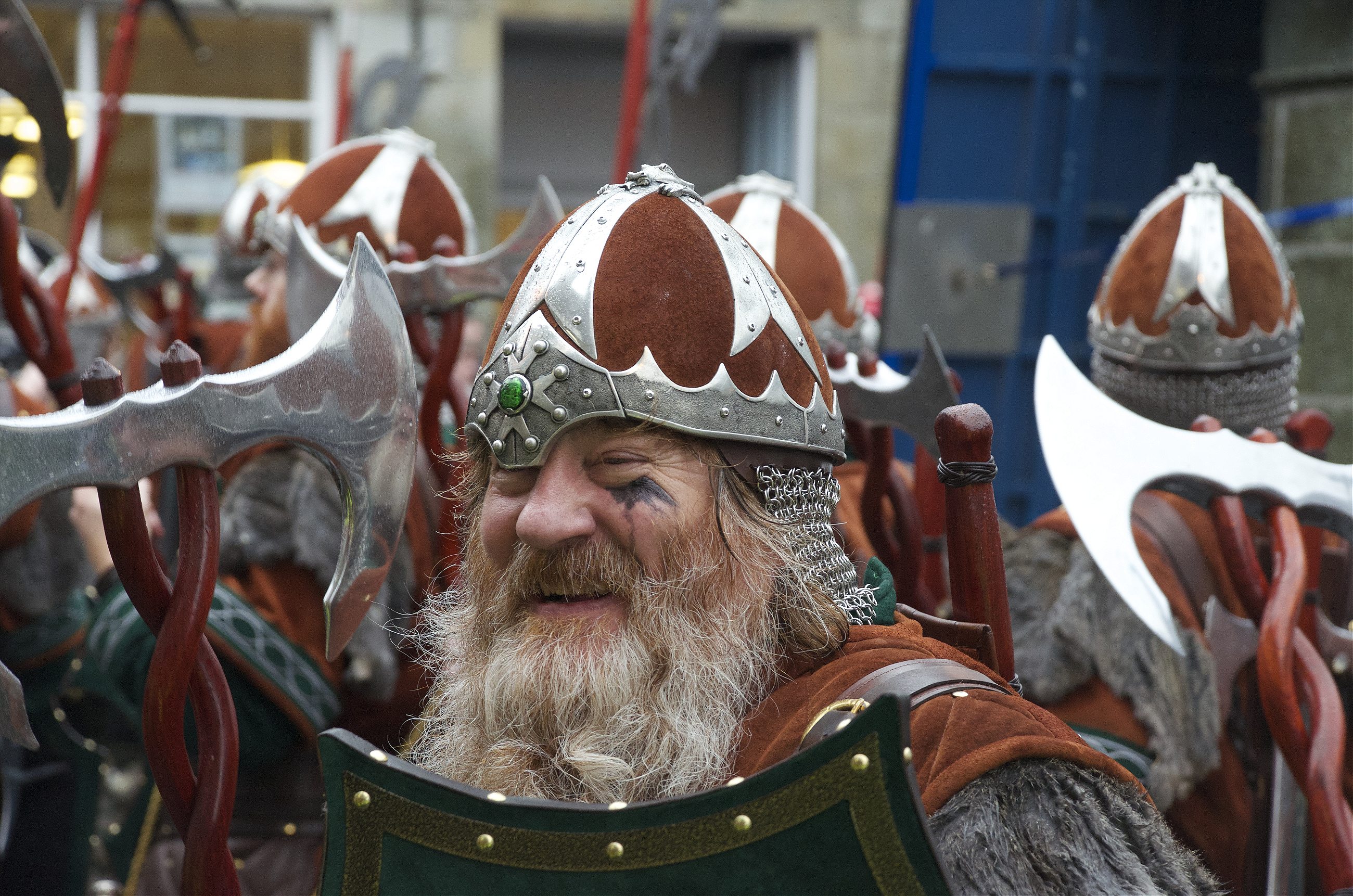
The torch-bearers swept down the road from the Hillhead in a fiery torrent. They coiled and whipped like a blazing Chinese dragon, as they made their way south along St. Olaf Street and down through Prince Alfred Street. The heat warmed the skin and the smell of paraffin stung the eyes. Camera shutters burred, the guizers yelled and the longship, travelling in the opposite direction, scythed through the fire like a ghostly spectre.
Slowly, the procession filed into George V Park, circling its perimeter. Inside, still atop his longship, stood Neil Robertson with his axe raised in the air for quiet. The moment had arrived.
He called out three cheers for the builders of the ship, three cheers for the torch-makers and again three cheers for Up Helly Aa. The crowd roared, pumping its torches in the air, like soldiers at a military rally.
Then, while the guizers returned with their own cheers for the Jarl, Robertson stepped down off the boat and into the darkness. A bugle sounded.
At first, there were nods. These nods turned into excited murmurs, which in turn became roars. The first man stepped forward and threw his torch onto the deck of the boat. So too did the second. Then, in a shower of coruscating, parabolic arcs so did the other thousand. The fire whipped up the shrouds and the rigging and spat out of the dragon’s mouth. The wood cracked and creaked. The crowd roared. And in a matter of minutes, the galley burned brightly.
A few meters away, Robertson watched as the mast toppled into the bowels of the boat. The flickering light obscured the expression on his face. The party was not over. Throughout the town, food was being prepared and halls cleared for the arrival of the squads. But perhaps for the Jarl, the excitement was overwhelmed by disbelief. Fifteen years had come and gone.
